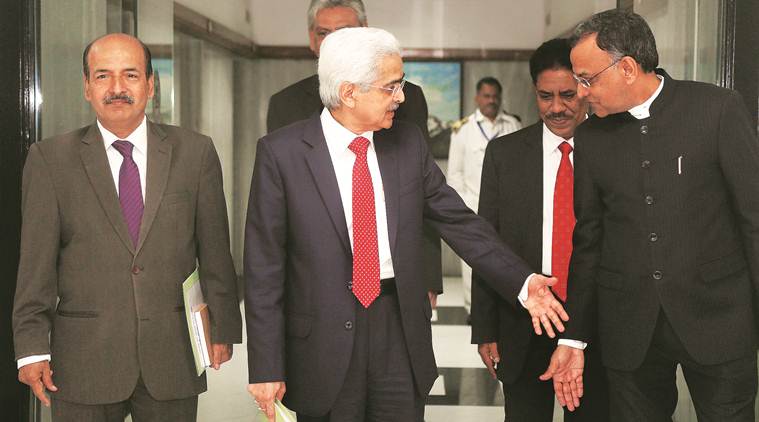RBI cuts rate by 35 basis points, cites concerns over growth
This is the fourth consecutive cut this year, bringing down the repo rate — the rate at which the RBI lends funds to banks — by a total of 110 basis points from 6.50 per cent.
 Reserve Bank of India Governor Shaktikanta Das (centre) along with RBI Deputy Governors in Mumbai on Wednesday. (Express photo by Prashant Nadkar)
Reserve Bank of India Governor Shaktikanta Das (centre) along with RBI Deputy Governors in Mumbai on Wednesday. (Express photo by Prashant Nadkar)
Moving to address the deepening slowdown, the Reserve Bank of India (RBI) Wednesday reduced its key policy rate by 35 basis points, the fourth consecutive interest rate cut this year, taking the benchmark lending rate to a nine-year low. The Monetary Policy Committee (MPC) decided to lower the repo rate by an unorthodox 35 basis points to 5.40 per cent. The higher-than-expected cut in the key policy rate could bring down lending and deposit rates of banks with State Bank of India announcing a reduction in its Marginal Cost Based Lending Rate (MCLR) by 15 basis points across all tenors within hours of the RBI rate cut.
This is the fourth consecutive cut this year, bringing down the repo rate — the rate at which the RBI lends funds to banks — by a total of 110 basis points from 6.50 per cent. Other central banks in Asia too are on a easing mode with the slowdown gripping many economies.
Unveiling the bi-monthly monetary policy review, RBI Governor Shaktikanta Das said: “Addressing growth concerns by boosting aggregate demand, especially private investment, assumes highest priority at this juncture while remaining consistent with the inflation mandate.”
Acknowledging the slowdown in the economy, the RBI also slashed the real GDP growth for 2019-20 from 7 per cent projected in the June policy to 6.9 per cent. The growth is likely to be in the range of 5.8-6.6 per cent for the first half of 2019-20.
The rate cut is aimed at tackling the pervasive slowdown, but for this to have a real impact, adequate transmission is key. That has not happened so far. The focus has to shift on improving transmission to bank lending rates, alongside renewed policy reforms aimed at restarting investment activity.
Many sectors like automobiles are facing a slump in demand. There has been a distinct slowdown in the economy and the problem has been compounded by the tight liquidity situation in non-banking finance companies (NBFCs), housing finance companies (HFCs) and the reluctance of banks to lend.
Opinion | Repo rate cut will help lower borrowing costs
The six-member MPC, Das said, felt it is prudent to remain accommodative. “While remaining consistent with inflation mandate, the MPC considered it necessary to calibrate a size of the policy repo rate cut to the dynamics of the situation. Accordingly, the MPC was of the view that the standard 25 basis point might prove to be inadequate in view of the evolving global and domestic macro economic developments,” he said.
On the other hand, reducing policy repo rate by 50 basis points “might be excessive” especially after the actions already undertaken by the RBI, Das said. “Reducing the policy repo rate by 35 basis points was, therefore, viewed as a balanced level of cut under the circumstances.”
While MPC members Chetan Ghate and Pami Dua voted for a 25 bps cut, Ravindra Dholakia, Michael Patra, BP Kanungo and Shaktikanta Das opted for a 35 bps reduction in repo rate and all six members voted for retaining the accommodative policy stance. This means a rate hike is off the table now.
Explained: Why has RBI cut lending rate by 35 bps? Why has GDP growth been revised downwards?
SBI Chairman Rajnish Kumar said the RBI decision to cut the repo rate by an unconventional 35 basis points is perhaps a recognition that monetary policy works best with unanticipated surprises to the market. “The RBI has unveiled a host of bazooka measures to arrest recent growth pangs even as it has marginally lowered its growth forecast for FY20,” he said.
The SBI said the 15 bps reduction in MCLR will be effective from August 10. With the latest cut, SBI home loans linked to MCLR rates are now cheaper by 35 bps since April 10. The one-year MCLR has now come down to 8.25 per cent per annum, from the earlier 8.40 per cent. Indian Banks Association Chairman and Punjab National Bank MD Sunil Mehta said, “This (repo rate cut) would go to reduce the lending rate offered by banks. Overall banks have reduced the interest rate on fresh rupee loans by 29 bps. With improvement in liquidity position and reduction in deposit rates offered by banks, further reduction in lending rate is expected.”
According to the RBI, inflation is currently projected to remain within the target over a 12-month ahead horizon. “Since the last policy, domestic economic activity continues to be weak, with the global slowdown and escalating trade tensions posing downside risks. Private consumption, the mainstay of aggregate demand, and investment activity remain sluggish,” the RBI said. Even as past rate cuts are being gradually transmitted to the real economy, the benign inflation outlook provides headroom for policy action to close the negative output gap, Das said.
Stating that banks should further lower their rates, he expressed confidence that the government would take further measures to revive growth. “There is a demand and investment slowdown. Both put together to have a dampening effect on growth… Our understanding, at this point, is that it is perhaps a cyclical slowdown, not really a deep structural slowdown. Nonetheless, we have to recognise that there is room for certain structural reforms, which need to be undertaken,” he said.
On the transmission of the monetary policy, Das said while there has been a reduction of monetary policy rates by 75 basis points from February to June 2019, banks have reduced their interest rates on fresh rupee loans by only 39 basis points. “Our interaction with both public and private sector banks indicate that steps are being taken by them on an ongoing basis to progressively lower their interest rates so that benefits of the policy rate reductions are passed on to the economy. We expect higher transmission of monetary policy action and stance by banks in the weeks and months ahead,” he said.
“In future whatever steps are required for faster transmission of rate, the RBI will not hesitate to take those steps,” he said.
On liquidity management, Das said there is an abundance of liquidity in the system currently, warranting absorption of surpluses by the RBI. As on August 6, surplus liquidity parked in the reverse repo window of the RBI is almost Rs 2 lakh crore.
He said the RBI is committed to ensuring that sufficient liquidity is available so that needs of all productive sectors of the economy are met. Towards this objective, the RBI will use its liquidity management instruments to ensure that the system’s requirements of both day-to-day liquidity and durable liquidity are adequately provided. Das said the RBI-constituted internal working group on liquidity management is at an advanced stage of deliberations and its recommendations will be available soon for public comment.





- 01
- 02
- 03
- 04
- 05


























